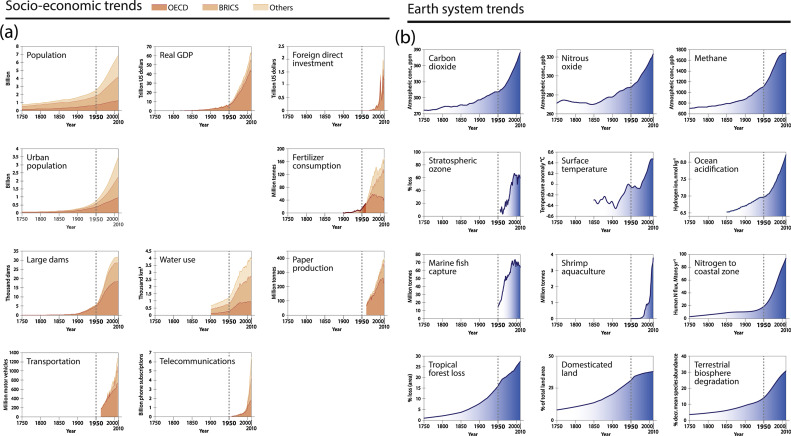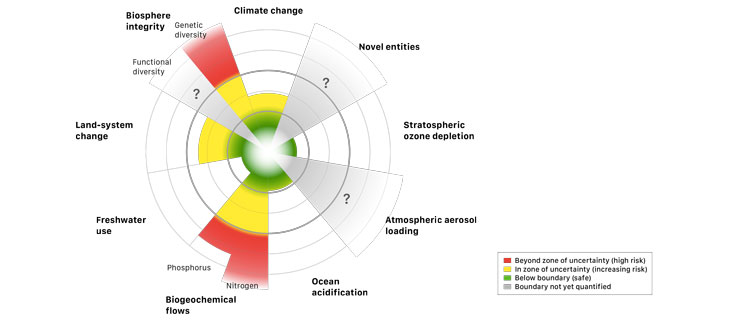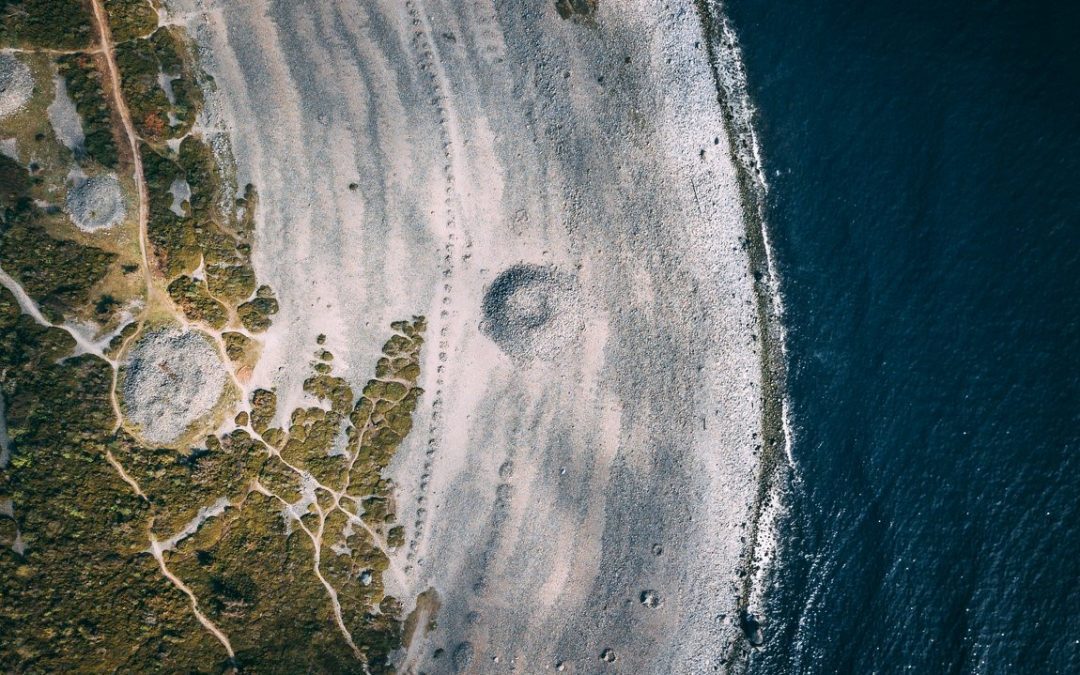By: Alexie Roy-Lafontaine
The growth of the world’s population inevitably leads to an increase in the demand for natural resources (water, energy, minerals, wood) and living spaces. These demands put pressure on ecosystems and will increase in the coming years [1]. The planet cannot sustain this continued growth: non-renewable natural resources are depleted; the impacts of climate change are beginning to manifest, and species are threatened more than ever. We are testing the limits of the Earth at our peril!
It seems therefore urgent to introduce a global paradigm that proposes a balance between the development of societies and the maintenance of the Earth system in its resilience capacity zone [2]. Since this issue is of global interest, it is all countries that must walk in the same direction. This is a major challenge as prioritized economic and social issues vary from country to country.
Over the past decade, the scientific community has developed the concept of planetary boundaries [3]. These limits refer to the boundaries within which humanity must navigate in order not to increase the risks of destabilizing the viable system and induce irreversible changes. Promised, this is not a difficult concept to understand!
These limits are defined by 9 quantifiable and qualifying environmental issues that encompass the climate, biosphere, atmosphere and lithosphere. Studies have shown that humans now have a significant impact on the mechanisms of these variables that act in concert.
First, before understanding the concepts discussed above, a contextualization of geology and the history of the planet is necessary.
Geologists break down the earth’s impressive history, which spans 4.5 billion years [4] in a line of time fragmented of various eras, epochs, periods and ages. Let’s talk about geological eras! We are currently the Holocene. This long, warm and relatively stable interglacial period that has stretched for more than 12,000 years [5] is the only one known to all that can support the development of life and the activities of contemporary societies [4].
Over the past 300 years, the effects of human activities on the Earth system have increased from local to global. Thus, towards the end of the 18th century, the environmental characteristics of the Holocene observed before the dominance of humans on the planet began to change. Studies of air captured in Antarctic ice masses (also known as paleoclimatic studies) show that form this period, concentrations of carbon dioxide and methane begin to increase significantly [6]. These greenhouse gases have the characteristic of modulating the global climate when their concentrations vary. Their molecules affect the behaviour of the Sun’s rays: a portion of the radiation that is supposed to be reflected to return to space remains trapped in the lower layers of the atmosphere, thus near the ground. This induces the amount of heat stored on the planet’s surface to be greater. This is how the greenhouse effect is increased. It is important to mention that the natural and indispensable greenhouse effect since without it, it would be -18 degrees Celsius on the surface of the Earth, temperature too cold to allow the development of life. However, due to anthropogenic activities, the increase in the phenomenon of the greenhouse effect is massively accelerated, risking the achievement of a rate unfavourable to the maintenance of life [6].
Several researchers suggest that we have moved into a new geological era: the Anthropocene, a term that refers to the dominance of humans on the planet. Indeed, more changes have occurred on the planet in the last three decades than in the last 200 million years. The first industrial revolution of 1750 or the Great Acceleration [7] was the trigger for the feedback observed on the Earth system (Figure 1). Studies conclude that the behaviours of the Earth system are directly related to socio-economic trends in human societies (Figure 1). Thus, humans are now the main drivers of global change.
 Figure 1: Socioeconomic Trends Related to Earth System Behavior [8]
Figure 1: Socioeconomic Trends Related to Earth System Behavior [8]
As shown in figure 1, the growth of human societies and their consumption habits are also increasingly influencing the components of the biosphere.
Although the geological era of the Anthropocene is not officially accepted by geologists, markers of human environmental practices will no doubt leave traces in the geology and sedimentation of the earth’s soil through intensive agriculture, deforestation, nuclear and transport exploitation [9].
In addition, we are witnessing the 6th mass extinction, one of which is the extinction of the dinosaurs. A study published in Science Advances in 2013 confirms that the current rate of species extinction could be 100 times higher than in previous mass extinctions [10]. In short, this is the first time in the history of the planet that a single species (Homo sapiens) has had such a powerful global impact [11].
Let’s go back to Figure 1. A range of planetary feedbacks is induced as a result of human pressures. That’s why we’re talking about an “Earth system”. Earth’s physical, chemical and biological processes interact together. The system encompasses land, oceans, atmosphere and poles (cryosphere) and includes natural biogeochemical cycles of carbon, water, nitrate, phosphorus, Sulphur and terrestrial processes. Here, what is important to remember is that all these variables are related. The system, therefore, has a strong resilience capacity. It can absorb disturbances and reorganize itself by inducing changes in its structure to keep essentially the same function: the maintenance of life. However, there is a threshold for this resilience of the planet and, at present, anthropogenic activities are eroding this disposition at a significant rate [4].
We have reached a stage where the 9 planetary boundaries established by the scientific community are controlled by human activities. The concept thus established a safe operating space for each of the variables and makes it the focus of their current state (Figure 2).
 Figure 2: The 9 Planetary Boundaries and Their Current States [11]
Figure 2: The 9 Planetary Boundaries and Their Current States [11]
Figure 2 shows the current state of the limit variables. The green zone represents the safe operating space, the yellow one is the area of uncertainty and the red one is that of exceeding the boundary area.
Currently, we have exceeded three limits: the diversity of the biosphere and the biogeochemical cycles of phosphorus and nitrogen. Changes in soil functions, which are quite high in the yellow zone, should also be monitored. Analysis of inter-limit interactions suggests that climate change and biosphere diversity are nuclei and that other variables revolve around them by adapting their feedbacks [3].
Let’s go over the boundaries to better understand them and adapt our behaviours
The main drivers of the degradation of biosphere diversity are the demand for food, water and natural resources. These resource pressures lead to severe losses in global biodiversity and lead to changes in ecosystem services. However, this degradation can be slowed by further protecting habitats and increasing connectivity between ecosystems, for example.
Emissions of toxic substances often have significant residency times in the environment (organic pollutants, heavy metals, radioactive materials, etc.). They can have irreversible effects on living organisms and on the physical environment by affecting atmospheric processes and climate. Also, this pollution type is difficult to quantify, and the impacts are observed in the long term. Thus, studies do not establish a threshold for this variable, but the mitigation of their use is required.
The concentration of carbon dioxide in the atmosphere currently exceeds 390 ppm, a concentration significantly higher than that established for the safe operating space. As a result, the impacts of climate change are already being observed. For example, the decline in polar ocean ice in summer is almost irreversible. Ocean levels are already rising. It is not known for how long we can exceed the limit without inducing irreversible changes.
Ocean surface waters are 30% more acidic than in the pre-industrial period. ¼ of the atmospheric greenhouse gas emissions emitted by humans are released in the oceans. This acidity has negative impacts on the survival and development of certain organisms (corals, shell organisms and plankton), directly affecting fish reserves.
The freshwater cycle is intrinsically linked to climate change. Humans are now the main determinants in the function and distribution of freshwater, which will become rarer in the years to come.
The land is converted to human use all over the world. Forests, fields, wetlands and other types of terrestrial biomes have been converted to agriculture land. The impacts of this variable on biodiversity, stream flows and biogeochemical cycles of carbon, nitrogen and phosphorus are well known.
The biogeochemical cycles of nitrogen and phosphorus have been radically altered by industrial and agricultural processes practiced by humans. Indeed, human activities release more nitrogen than all earthly processes combined. Human-produced nitrogen and phosphorus accumulate in streams or in the terrestrial biosphere, depleting these oxygen environments and directly affecting biological diversity.
Aerosols have a direct impact on the climate system by altering the amount of solar radiation reflected or absorbed into the atmosphere. Interaction with water vapours, they affect the hydrological cycle through cloud formation mechanisms and atmospheric circulation patterns.
Finally, stratospheric ozone filters the Sun’s ultraviolet rays (UV). If the ozone layer thins and punctures, more UV rays will reach the ground, increasing the risk of cancer and affecting biological marine terrestrial ecosystems (12).
More optimistic news is that we have already succeeded in reversing the critical state of stratospheric ozone depletion. Indeed, following the appearance of the hole in the ozone layer at the Antarctic level, the international agreement of the Montreal Protocol was established. By phasing out the production and consumption of 165 ozone-depleting substances and hydrofluorocarbons (CFCs), the state of the ozone layer has been restored, placing this agreement on the podium on international agreements (13). So, if we can meet a limit, we can get there for the 9!
The Holocene geological era supports human life, but the consumption habits and current economic models of societies are not sustainable to maintain the equilibrium state of the Earth system. Various changes to the foundations of societies are currently being initiated by international governments. The implementation of waste management policies (14), targets for greenhouse gas emissions reduction and the introduction of the principles of circular economy (to be presented in the next article) are examples of measures put in place to improve compliance with the Earth’s limits. However, since responsible consumption is not adopted by the majority of the citizens of the Earth system, the pressure is increasing on the limit variables. Reducing the purchase of single-use plastics, avoiding overconsumption and using active and collective transport more are important everyday actions to reduce the pressure on global natural resources. Respecting the limits of the planet also means ensuring our quality of life!

